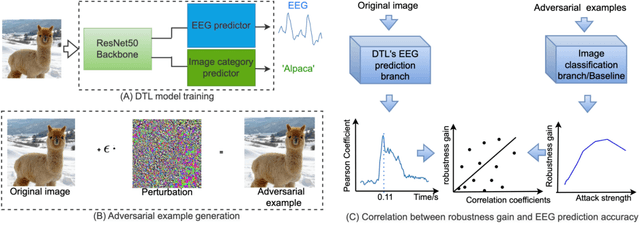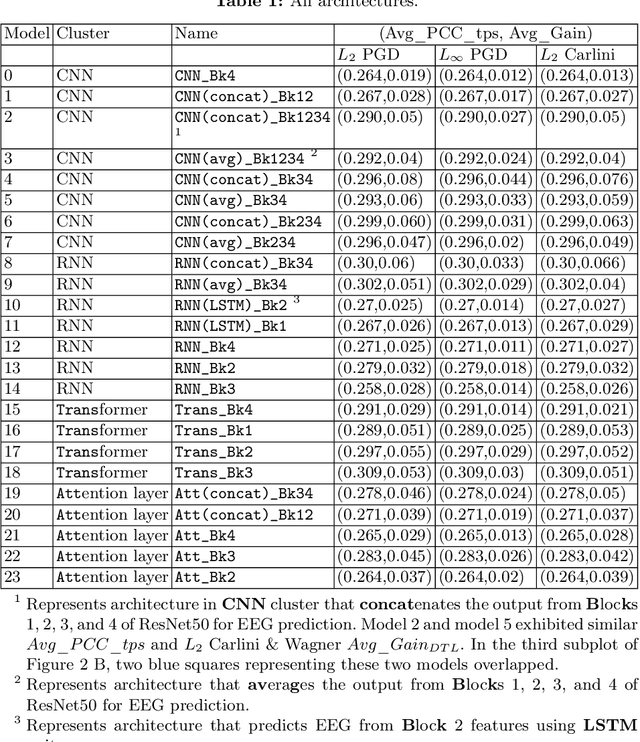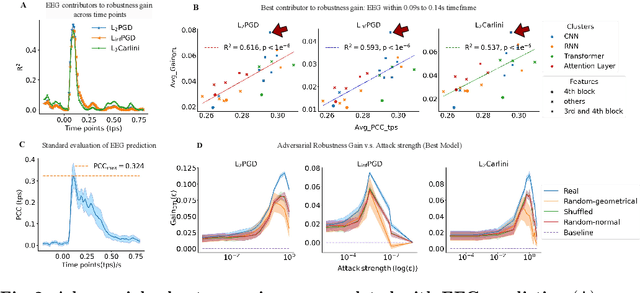Radoslaw M. Cichy
Limited but consistent gains in adversarial robustness by co-training object recognition models with human EEG
Sep 05, 2024



Abstract:In contrast to human vision, artificial neural networks (ANNs) remain relatively susceptible to adversarial attacks. To address this vulnerability, efforts have been made to transfer inductive bias from human brains to ANNs, often by training the ANN representations to match their biological counterparts. Previous works relied on brain data acquired in rodents or primates using invasive techniques, from specific regions of the brain, under non-natural conditions (anesthetized animals), and with stimulus datasets lacking diversity and naturalness. In this work, we explored whether aligning model representations to human EEG responses to a rich set of real-world images increases robustness to ANNs. Specifically, we trained ResNet50-backbone models on a dual task of classification and EEG prediction; and evaluated their EEG prediction accuracy and robustness to adversarial attacks. We observed significant correlation between the networks' EEG prediction accuracy, often highest around 100 ms post stimulus onset, and their gains in adversarial robustness. Although effect size was limited, effects were consistent across different random initializations and robust for architectural variants. We further teased apart the data from individual EEG channels and observed strongest contribution from electrodes in the parieto-occipital regions. The demonstrated utility of human EEG for such tasks opens up avenues for future efforts that scale to larger datasets under diverse stimuli conditions with the promise of stronger effects.
Net2Brain: A Toolbox to compare artificial vision models with human brain responses
Aug 25, 2022

Abstract:We introduce Net2Brain, a graphical and command-line user interface toolbox for comparing the representational spaces of artificial deep neural networks (DNNs) and human brain recordings. While different toolboxes facilitate only single functionalities or only focus on a small subset of supervised image classification models, Net2Brain allows the extraction of activations of more than 600 DNNs trained to perform a diverse range of vision-related tasks (e.g semantic segmentation, depth estimation, action recognition, etc.), over both image and video datasets. The toolbox computes the representational dissimilarity matrices (RDMs) over those activations and compares them to brain recordings using representational similarity analysis (RSA), weighted RSA, both in specific ROIs and with searchlight search. In addition, it is possible to add a new data set of stimuli and brain recordings to the toolbox for evaluation. We demonstrate the functionality and advantages of Net2Brain with an example showcasing how it can be used to test hypotheses of cognitive computational neuroscience.
Deep Neural Networks predict Hierarchical Spatio-temporal Cortical Dynamics of Human Visual Object Recognition
Jan 12, 2016



Abstract:The complex multi-stage architecture of cortical visual pathways provides the neural basis for efficient visual object recognition in humans. However, the stage-wise computations therein remain poorly understood. Here, we compared temporal (magnetoencephalography) and spatial (functional MRI) visual brain representations with representations in an artificial deep neural network (DNN) tuned to the statistics of real-world visual recognition. We showed that the DNN captured the stages of human visual processing in both time and space from early visual areas towards the dorsal and ventral streams. Further investigation of crucial DNN parameters revealed that while model architecture was important, training on real-world categorization was necessary to enforce spatio-temporal hierarchical relationships with the brain. Together our results provide an algorithmically informed view on the spatio-temporal dynamics of visual object recognition in the human visual brain.
 Add to Chrome
Add to Chrome Add to Firefox
Add to Firefox Add to Edge
Add to Edge